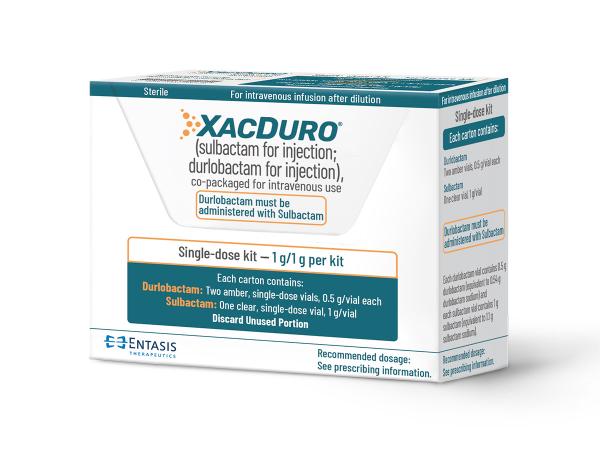Durlobactam/sulbactam Disease Interactions
There are 2 disease interactions with durlobactam / sulbactam.
Antibiotics (applies to durlobactam/sulbactam) colitis
Major Potential Hazard, Moderate plausibility. Applicable conditions: Colitis/Enteritis (Noninfectious)
Clostridioides difficile-associated diarrhea (CDAD), formerly pseudomembranous colitis, has been reported with almost all antibacterial drugs and may range from mild diarrhea to fatal colitis. The most common culprits include clindamycin and lincomycin. Antibacterial therapy alters the normal flora of the colon, leading to overgrowth of C difficile, whose toxins A and B contribute to CDAD development. Morbidity and mortality are increased with hypertoxin-producing strains of C difficile; these infections can be resistant to antimicrobial therapy and may require colectomy. CDAD must be considered in all patients who present with diarrhea after antibacterial use. Since CDAD has been reported to occur more than 2 months after antibacterial use, careful medical history is necessary. Therapy with broad-spectrum antibacterials and other agents with significant antibacterial activity should be administered cautiously in patients with history of gastrointestinal disease, particularly colitis; pseudomembranous colitis (generally characterized by severe, persistent diarrhea and severe abdominal cramps, and sometimes associated with the passage of blood and mucus), if it occurs, may be more severe in these patients and may be associated with flares in underlying disease activity. Antibacterial drugs not directed against C difficile may need to be stopped if CDAD is suspected or confirmed. Appropriate fluid and electrolyte management, protein supplementation, antibacterial treatment of C difficile, and surgical evaluation should be started as clinically indicated.
References (40)
- (2002) "Product Information. Omnipen (ampicillin)." Wyeth-Ayerst Laboratories
- (2002) "Product Information. Ceftin (cefuroxime)." Glaxo Wellcome
- (2002) "Product Information. Zinacef (cefuroxime)." Glaxo Wellcome
- (2002) "Product Information. Cleocin (clindamycin)." Pharmacia and Upjohn
- (2002) "Product Information. Macrobid (nitrofurantoin)." Procter and Gamble Pharmaceuticals
- (2002) "Product Information. Macrodantin (nitrofurantoin)." Procter and Gamble Pharmaceuticals
- (2001) "Product Information. Amoxil (amoxicillin)." SmithKline Beecham
- (2001) "Product Information. Merrem (meropenem)." Astra-Zeneca Pharmaceuticals
- (2001) "Product Information. Coly-Mycin M Parenteral (colistimethate)." Parke-Davis
- (2001) "Product Information. Lincocin (lincomycin)." Pharmacia and Upjohn
- (2003) "Product Information. Cubicin (daptomycin)." Cubist Pharmaceuticals Inc
- (2004) "Product Information. Xifaxan (rifaximin)." Salix Pharmaceuticals
- (2007) "Product Information. Doribax (doripenem)." Ortho McNeil Pharmaceutical
- (2009) "Product Information. Penicillin G Procaine (procaine penicillin)." Monarch Pharmaceuticals Inc
- (2009) "Product Information. Vibativ (telavancin)." Theravance Inc
- (2010) "Product Information. Teflaro (ceftaroline)." Forest Pharmaceuticals
- (2022) "Product Information. Penicillin G Sodium (penicillin G sodium)." Sandoz Inc
- (2014) "Product Information. Dalvance (dalbavancin)." Durata Therapeutics, Inc.
- (2014) "Product Information. Orbactiv (oritavancin)." The Medicines Company
- (2017) "Product Information. Bicillin C-R (benzathine penicillin-procaine penicillin)." A-S Medication Solutions
- (2017) "Product Information. Baxdela (delafloxacin)." Melinta Therapeutics, Inc.
- (2022) "Product Information. Polymyxin B Sulfate (polymyxin B sulfate)." AuroMedics Pharma LLC
- (2018) "Product Information. Zemdri (plazomicin)." Achaogen
- (2018) "Product Information. Seysara (sarecycline)." Allergan Inc
- (2018) "Product Information. Nuzyra (omadacycline)." Paratek Pharmaceuticals, Inc.
- (2018) "Product Information. Aemcolo (rifamycin)." Aries Pharmaceuticals, Inc.
- (2019) "Product Information. Biaxin (clarithromycin)." AbbVie US LLC, SUPPL-61
- (2021) "Product Information. Zithromax (azithromycin)." Pfizer U.S. Pharmaceuticals Group, LAB-0372-7.0
- (2018) "Product Information. E.E.S.-400 Filmtab (erythromycin)." Arbor Pharmaceuticals, SUPPL-74
- (2020) "Product Information. Priftin (rifapentine)." sanofi-aventis, SUPPL-18
- (2021) "Product Information. Xerava (eravacycline)." Tetraphase Pharmaceuticals, Inc
- (2023) "Product Information. Xacduro (durlobactam-sulbactam)." La Jolla Pharmaceutical
- (2024) "Product Information. Exblifep (cefepime-enmetazobactam)." Allecra Therapeutics
- (2021) "Product Information. Maxipime (cefepime)." Hospira Inc, SUPPL-46
- (2021) "Product Information. Mycobutin (rifabutin)." Pfizer U.S. Pharmaceuticals Group, SUPPL-26
- (2025) "Product Information. Emblaveo (avibactam-aztreonam)." AbbVie US LLC
- (2024) "Product Information. Zevtera (ceftobiprole)." La Jolla Pharmaceutical
- (2021) "Product Information. Kimyrsa (oritavancin)." Melinta Therapeutics, Inc.
- (2021) "Product Information. Azactam (aztreonam)." Bristol-Myers Squibb, SUPPL-46
- (2025) "Product Information. Fetroja (cefiderocol)." Shionogi USA Inc, SUPPL-9
Beta-lactamase inhibitors (applies to durlobactam/sulbactam) renal dysfunction
Moderate Potential Hazard, Moderate plausibility.
Beta-lactamase inhibitors are available in combination with beta-lactam antibacterial agents. Beta-lactamase inhibitors are primarily eliminated by the kidneys, with 75% to 100% of the administered dose excreted as unchanged drug. The plasma exposures (AUC) of beta-lactamase inhibitors (and the associated beta-lactam antibacterial agents) are increased with decreasing renal function. Dosage adjustments are generally necessary for products containing beta-lactamase inhibitors, and modifications should be based on the degree of renal dysfunction in accordance with the individual manufacturer product information. Because it may change during the course of therapy, renal function should be monitored regularly and the dosage should be adjusted accordingly, as appropriate.
Beta-lactamase inhibitors and beta-lactam antibacterial agents can be removed by hemodialysis. The dose should be administered after hemodialysis on hemodialysis days.
References (8)
- (2022) "Product Information. Zerbaxa (ceftolozane-tazobactam)." Merck Sharp & Dohme LLC, SUPPL-12
- (2022) "Product Information. Avycaz (avibactam-ceftazidime)." Forest Pharmaceuticals, SUPPL-11
- (2023) "Product Information. Xacduro (durlobactam-sulbactam)." La Jolla Pharmaceutical
- (2020) "Product Information. Recarbrio (imipenem/cilastatin/relebactam)." Merck Sharp & Dohme LLC, SUPPL-2
- (2022) "Product Information. Zosyn (piperacillin-tazobactam)." Baxter I.V. Systems Division, SUPPL-49
- (2020) "Product Information. Unasyn (ampicillin-sulbactam)." Pfizer U.S. Pharmaceuticals Group, SUPPL-47
- (2024) "Product Information. Exblifep (cefepime-enmetazobactam)." Allecra Therapeutics
- (2025) "Product Information. Emblaveo (avibactam-aztreonam)." AbbVie US LLC
Switch to consumer interaction data
Durlobactam/sulbactam drug interactions
There are 27 drug interactions with durlobactam / sulbactam.
More about durlobactam / sulbactam
- durlobactam/sulbactam consumer information
- Check interactions
- Compare alternatives
- Side effects
- Dosage information
- During pregnancy
- Drug class: beta-lactamase inhibitors
- En español
Related treatment guides
Drug Interaction Classification
| Highly clinically significant. Avoid combinations; the risk of the interaction outweighs the benefit. | |
| Moderately clinically significant. Usually avoid combinations; use it only under special circumstances. | |
| Minimally clinically significant. Minimize risk; assess risk and consider an alternative drug, take steps to circumvent the interaction risk and/or institute a monitoring plan. | |
| No interaction information available. |
See also:
Further information
Always consult your healthcare provider to ensure the information displayed on this page applies to your personal circumstances.


